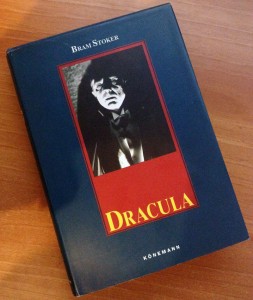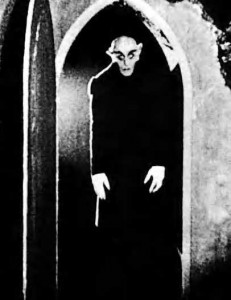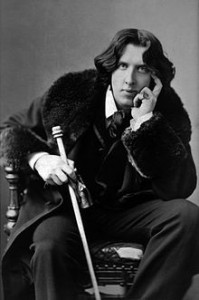He’s the daddy of all vampires, the lord of the undead we all hark back to. His name is Dracula. Or Dracul. Or Dra. Or D. (Sorry, went off on an Eddie Izzard tangent.)
But despite his fame and his god-like place in Gothic literature, I doubt many people have taken the time to read the original story. It’s kind of like the Bible. Plenty of us refer to it (and some of us even profess to live by it) but how many of us have actually read it? (And just for the record, I read the Bible. Fascinating stuff. Really.)

My copy of Dracula with Bela Lugosi on the cover.
So I read Dracula by Bram Stoker while I was at university. My fascination with vampires was in its deepest throes with story after story about the blood-sucking fiends offered up to my lecturers for comment. But it didn’t end there. Vampire literary theory was a whole other area I started to sink my teeth into. I was all too ready to find out what this original text, this early founder for the literature I so craved, had in store for me. How much richer would my understanding become if I only absorbed its teachings?
The copy I read was a cheap version bought at the bookstore for about $3. This was before the time when ebooks had become readily available. If I’d thought about it, I could have downloaded a copy from somewhere for free and read it on the computer, considering it’s now out of copyright, but for the sake of three bucks, I’m happy to still have the little volume on my bookshelf.
Of course. You get what you pay for. The edition was littered with plenty of typesetter errors so reading at times was a little like reading an English translation of a German translation of a Swahili novel. However, the majority of the text was fine and I got through from one to the other. If you’re not familiar with Dracula, it’s basically written as a series of diary entries, letters and newspaper articles. It was quite novel to read a story set out like this, which I know was quite common at the time. I was intrigued by how the description of Dracula himself is always mediated through the understandings of others. The reader doesn’t ever really know Dracula, just knows about him from observations and accounts made by humans. Quite different from the majority of today’s stories – mine included – where you get to hear the vampire’s innermost thoughts.

From the film Nosferatu. Director Murnau wanted to make a film version of Dracula but Stoker’s widow refused to give him the rights. Murnau created Nosferatu instead but it wasn’t an entirely original story.
Dracula, the character, is pretty horrible. There’s little to redeem him and he’s pretty off-putting physically. I can’t imagine anyone really wanting to talk to him, let alone have a roll in the hay. His skin is sallow, he has a long white moustache and he’s dressed in black from head to toe. As the story progresses, the description of him gets worse, and really does reinforce the image of the walking undead, of something unclean.
Most people are aware that Dracula is based on the Transylvanian ruler, Vlad the Impaler (also called Dracula, which meant “Devil”). Scourge of the Turks, saviour – and indiscriminate slaughterer – of the Romanians, and all round nasty guy (though regarded as a hero by some as he kept the Turks at bay – using some unorthodox methods). There’s even reference in Dracula to this fearful hero saying, “Again, when, after the battle of Mohacs, we threw off the Hungarian yoke, we of the Dracula blood were amongst their leaders, for our spirit would not brook that we were not free.”
But for me the more interesting connection that exists between Dracula and a living person is his connection to Oscar Wilde. There is literary speculation – which is pretty convincing in my opinion – that suggests Dracula is actually a representation of Oscar Wilde. Bram Stoker completed Dracula in 1896 and it was published in 1897 which was about the time of Oscar Wilde’s trial for homosexuality. At the time of the trials, the media created a monster out of Wilde and it was this image that Stoker put into the novel – the nocturnal living, his owning of two properties and even the description of Wilde’s bloated and horrifying appearance was used to describe the sleeping Dracula. The public at the time were well aware of Wilde and Stoker used this when writing Dracula. Some even say Stoker himself was homosexual and had a grudge against Wilde.
Of course, you can draw long bows between almost anything but I like the connection with Oscar Wilde as it gives a sense of history to the whole gay-as-vampire metaphor. Either overt or covert, vampires are often subversive, hidden-yet-in-plain-sight, like-us-but-not-like-us. There are always some “tells” as well, the colour of the skin, the aversion to light in preference to the darkness, the secrecy, the “unholy” desires and urges.
One of the most interesting readings of Dracula I ever read was about the blood transfusion scene where all the men give their blood to Lucy in order to save her from Dracula’s power. In this reading, Lucy is only there so men can touch each other through her. Women in Dracula always seem to act as a conduit for men to be able to express their true desires (apparently Dracula is there to turn everyone gay and he does that by getting rid of the woman, leaving men with little choice but to fall for each other).
Funnily enough, I heard a comment recently about stories where siblings have sex with the same partner (but not at the same time, threesome-style) are considered incest because “through the woman the two men touch”. I suppose it depends on how you read it or how strongly the author wants to push that particular line. Just flicking through the pages now, there’s some dialogue where Dracula is speaking to Harker in the castle and says: “We are in Transylvania; and Transylvania is not England. Our ways are not your ways, and there shall be to you many strange things. Nay, from what you have told me of your experiences already, you know something of what strange things here may be.”
Read that how you will.
An After Thought
Dracula isn’t the first vampire story, not by a long shot. Vampires had appeared in folklore and literature long before Stoker. Goethe’s ballad poem of 1797, The Bride of Corinth, is taken to be the moment when vampires played a part in “serious” literature. I haven’t checked it out yet but might be worth a look.
And if you’re interested in some of the research about Dracula-as-Wilde, check out Talia Schaffer’s essay, “A Wilde Desire Took Me: The Homoerotic History of Dracula“, published by English Literary History (Volume 61.2).


Leave a Reply